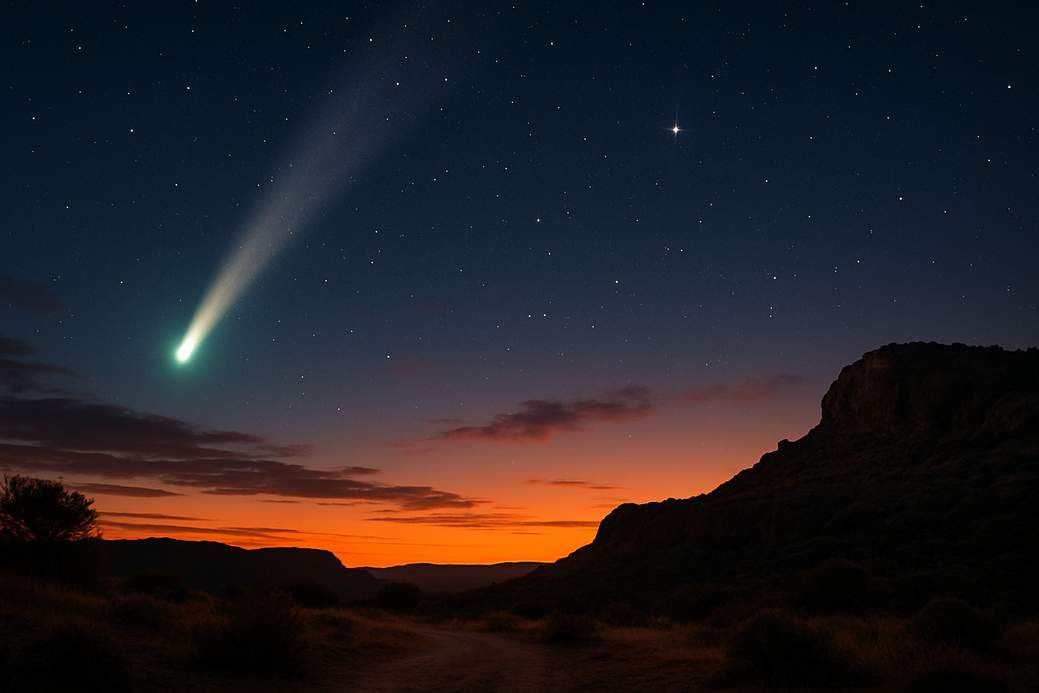October’s sky is a vibe
October nights are doing their best impression of a dramatic rom-com backdrop: cool, clear and begging you to look up. If you’ve been waiting for a reason to ditch the couch and stare at the heavens, this month serves it up—green comets, two meteor showers, and familiar planets showing off.
Meet the spooky green comet trio
Three comets discovered this year—C/2025 A6 (Lemmon), C/2025 R2 (Swan) and C/2025 K1 (Atlas)—are all on the move and could brighten enough to be seen with binoculars, or maybe even the naked eye if they’re feeling dramatic. They’ve got that eerie glow thanks to gas chemistry in their heads and tails, so think glow-stick-in-space vibes.
Comet Swan is skirting the sun right now, which makes it a bit shy, but it should calm down and become easier to spot as it moves away from solar glare. It’s expected to make its closest approach to Earth around Oct. 20 and might put on a binocular-friendly show. There’s also a chance it could leave behind a tiny meteor show of its own in early October.
Lemmon is another green-headed visitor that’s been brightening and getting attention from amateur astronomers. You can catch it in predawn skies through mid-month; after that it may shift into evening view. Atlas is the faintest of the trio but could peak in brightness in early October, so it’s worth a glance if you’ve got clear skies.
Two meteor showers (bonus overlap)
Meteors this month are a tale of two showers. The Draconids run roughly Oct. 6–10 and peak around Oct. 8. They’re slow-moving meteors—easier to follow as streaks across the sky—but the bright-ish moon near the peak will make spotting them tougher. Expect a modest show, about ten an hour at best.
The Orionids, meanwhile, are the steadier option and peak on Oct. 22, which lines up with a new moon this year—perfect dark-sky conditions. That shower stretches into mid-November and typically delivers a handful of meteors per hour, leftovers from Halley’s Comet. In short: choose Oct. 8 if you’re patient and outdoorsy, and Oct. 22 if you want darker skies and better odds.
Planets: the reliable celebrities
Planets don’t ghost you the way comets do. Early risers can spot Venus—the classic morning star—with Jupiter hanging out above it. Jupiter creeps into evening visibility by the end of the month, roughly around 10:30 p.m. Mercury shows up after sunset but hugs the horizon like a shy party guest, so it’s easy to miss. Saturn climbs up near the eastern horizon after dark, and although its famous rings aren’t favorably placed this month, a small telescope can still reveal cool shadow transits when Saturn’s moons cast tiny dark dots across the planet.
Andromeda, constellations and friendly star parties
October is one of the best months to hunt down the Andromeda Galaxy—the faint fuzz you can sometimes spot without equipment, sitting about 2.5 million light-years away. Use the nearby ‘W’ of Cassiopeia or the square of Pegasus to help guide you. Perseus and Cepheus are also up there providing stellar company.
If you’d rather let experts handle the telescopes, look for local star parties and public observing nights—there’s usually at least one decent public event in early to mid-October where folks bring dozens of scopes and show off planets, star clusters, and the Moon’s craters. No links here—just Google your local astronomy club or check community event listings.
How to watch (so you don’t freeze or miss the show)
Basic survival kit for sky-gazing: a comfy chair or blanket, warm layers, binoculars if you have them, and a dark spot away from city lights. Patience is key; comets can surprise you by flaring up, or they can fizzle—either way, it’s part of the fun. Serious chasers keep an eye on official updates from NASA or astronomy apps for the latest positions and brightness estimates.
And finally: temper expectations with curiosity. You might witness a once-in-a-lifetime firework, or you might just enjoy a crisp evening under the stars. Either outcome = success.














